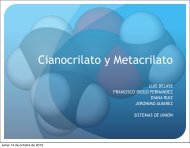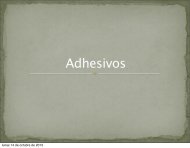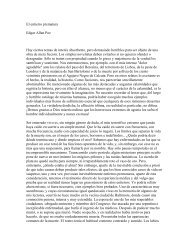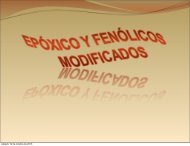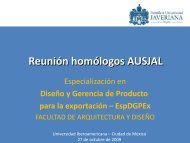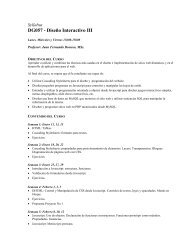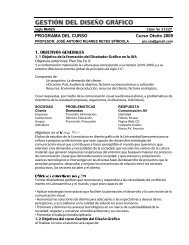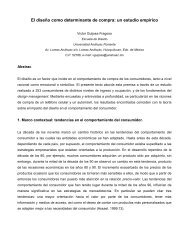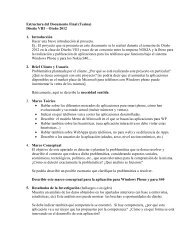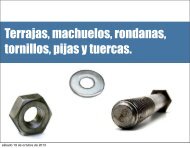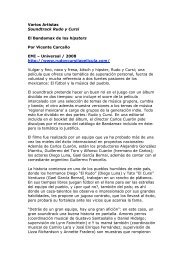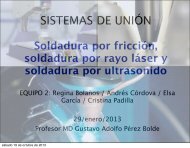Diseño sin FronterasDesign in Teaching and Learning Situations:an interdisciplinary dialogueCristina Portugal.PUC - Rio <strong>de</strong> Janeiro, Brazilcrisportugal@gmail.comRita Maria <strong>de</strong> Souza Couto.PUC - Rio <strong>de</strong> Janeiro, Brazilricouto@puc-rio.brIntroductionThis paper refers to the study, research and theoretical lineof research Design in Teaching and Learning Situationsthrough an interdisciplinary dialogue between Design andEducation. Through methods and techniques of <strong>de</strong>signit was sought to i<strong>de</strong>ntify how this area of knowledge canparticipate in the processes of teaching and learning at thesetting of learning materials and enhance the processof acquiring knowledge. The study was gui<strong>de</strong>d by theMulti-Tracks, subject of this investigation, which is agame to help the acquisition of a second languageby <strong>de</strong>af children. This game was <strong>de</strong>veloped in thelight of methods and techniques of Design, un<strong>de</strong>r theInterdisciplinary Laboratory of Design / Education - LIDE,Pontifical Catholic University of Rio <strong>de</strong> Janeiro, Brazil, inpartnership with the National Institute of Education forthe Deaf in Rio <strong>de</strong> Janeiro - INES / RJ.This study intends to present Design as a field that cancontribute effectively towards the creation of educationalartifacts and cultural inventions, important aspects inhuman’s cognitive <strong>de</strong>velopment.According to Bonsiepe (1997), Design is the domain inwhich interaction between user and product is structuredto facilitate effective actions. Fontoura (2002) says Design isan ample field that involves and to which different disciplinesconverge. It can be seen as an activity, as a process orun<strong>de</strong>rstanding in terms of its tangible results. It can be seenas a function of project management, as a project activity,as a conceptual activity, or even as a cultural phenomenon.It is viewed as a means to add value to things produced byhumans and also as a vehicle for social and political change.Design is an active process that influences society, creatingits material culture. From this perspective, Meurer, cited byFrascara (1997) says:The world in which we live is more than the matter that has solidifiedas form and remained over time. Its form is <strong>de</strong>fined by activity andaction is its center. If Design is conceived as oriented towards action,un<strong>de</strong>rstood as active interaction and creative change, it will not focuson the object only as form. Quite the contrary, <strong>de</strong>signers shallconcern themselves with <strong>de</strong>veloping interactive process mo<strong>de</strong>ls inwhich object play an indisputable core role as a means for action.According to this vision, Design relates to the totality of humaninteraction’s concrete and intellectual spectrum, of interactionamong people, products and the world in which we live. (Meurer,apud Frascara, 1997, p. 220).Starting with a vision open to inclusion, which characterizesDesign’s area, this study <strong>de</strong>fends the i<strong>de</strong>a that the Designfield has great potential for joint works with Education,aimed at meeting contemporary society’s new <strong>de</strong>mands. Itwas precisely this un<strong>de</strong>rstanding that led to the reflectionsfound herein about the possibilities of an interdisciplinarydialogue between Design and Education as a basis for theconceptualization of the “Design in Teaching-LearningSituations” line of investigation.Using this <strong>de</strong>finition of Design as a field, which in Meurer’swords “relates to the totality of human interaction’s concreteand intellectual spectrum”, we will show the path takenfor carrying out this research.Research ProcessIn 2004, the LIDE team began to <strong>de</strong>velop a research projectentitled ‘Multi-Paths: game to assist in the acquisition ofa second language by <strong>de</strong>af children’. The public for thisproject, which was carried out from 2004 to 2007, was <strong>de</strong>afchildren enrolled in elementary school at the NationalInstitute of Deaf Education of Rio <strong>de</strong> Janeiro - INES/RJ.This research project, which had a clear interdisciplinaryapproach, received a “Scientists from Our State” scholarshipfrom FAPERJ (2005-2007) and a Productivity in Researchscholarship from CNPq (2006-2009).The actual object is a path game for tables or floors. Thepath is comprised of regular polygons, and besi<strong>de</strong>s these,the Multi-Tracks Game also has three sets of three scenarioseach: Pão <strong>de</strong> Açúcar, Fire Department and Zoo, actioncards, bonus cards, command cards, support cards, pinsand dice. The multimedia object is a game that consists ofan outing in the city of Rio <strong>de</strong> Janeiro, initially starting at37
MX Design Conference 2011the three sets of three scenarios each, as per the scenariosof the actual object. Each scenario has links to three tasks:a jig-saw puzzle, a connect-the-dots and a word/imageassociation puzzle.With Multi-Tracks as a starting point, we elaborate a studywith the objective of conceptualizing, <strong>de</strong>limiting andgrounding the Design in Situations of Teaching-learningline of investigation.The question that gui<strong>de</strong>d this study was: can Designtechniques and methods applied to Design in Situations ofTeaching-Learning promote the enhancement and enrichmentof the teaching-learning process for children? Weconducted this study starting with the i<strong>de</strong>a that the job ofa good <strong>de</strong>signer within the scope of Education, which is inlarge part seen as a project activity, at the same level as theone that leads to the configuration of maps, posters, books,etc., is somewhat restrictive.In or<strong>de</strong>r to discuss these issues, our general objectivebecame to ground the Design in Situations of Teaching-Learning line of investigation to form the basis for discussionswe intend to carry out.The methodological aspects that served as a gui<strong>de</strong> tothis investigation, which had a qualitative bias, are shownbelow in the synthesis table for the research process. Eachof these phases is related to an objective. Notwithstandingthe presentation in phases, the research process wasfoun<strong>de</strong>d on concomitant actions.The concept map shows the main issues addressed in thisstudy.In this paper, we shall present the issues related toteaching-learning, which correspond to the fourth phase ofthe research.Design and issues about teaching-learningAs a subsidy for <strong>de</strong>fining the Design in Situations ofTeaching-Learning field in this study so the <strong>de</strong>signer canun<strong>de</strong>rstand how to operate in the Design/Educationfield, we shall introduce Shulman’s Mo<strong>de</strong>l of PedagogicalReasoning and Action (2008).Although this mo<strong>de</strong>l is presented in a sequential manner,the author says this does not intend to represent a seriesof fixed phases, stages or steps. Many of the processescan occur simultaneous to the others. Some may not evenhappen during some teaching actions. Some may appearsectioned and others, on the contrary, <strong>de</strong>fined in <strong>de</strong>tails.For example, it is probable that in teaching children someof these processes may be ignored or some may not bepaid attention to in this mo<strong>de</strong>l. However, a teacher shouldbe able to <strong>de</strong>monstrate ability to participate in these processes.Faculty preparation must provi<strong>de</strong> the stu<strong>de</strong>nts withforms of comprehension and with performance skills theyrequire to move forward following an or<strong>de</strong>r and to carryout complete acts of pedagogy, as has been represented inthe mo<strong>de</strong>l of pedagogical reasoning and action.Research Process1 st Phase 2 nd Phase 3 rd Phase 4 th Phase 5 th PhaseDocumental researchCase StudyDocumentation andanalysis of the Multi-Tracks game projectprocessBibliographic Research Bibliographic Research Conceptualization ofthe line of researchReading and criticalanalysis of textsReading and critical analysisof textsReading and criticalanalysis of textsResultsI<strong>de</strong>ntification ofmethodology forDesign in Situations ofTeaching-LearningOperational objective Operational objective Operational objective General objective Operational objectiveConduct a systematicregistry of thehistory of Multi-Tracksconfiguration.Base and discuss Designquestions in light ofinformation and communicationtechnologies,addressing culturalaspects, language, imageand construction ofmeaning.Present studies on Design/Education, discussing issuesrelated to teaching-learning,games and visual pedagogicalpractices.Discuss the Design inEducation line in light ofopinions and reflections of<strong>de</strong>signers that work in theaca<strong>de</strong>mic area.Ground the Design inSituations of Teaching-Learning line ofinvestigation.Contribute towards thefield of Design and ofEducation in creatingsubsidies for planningeducational materials andfor improving standards ofeducation, making learningmore productive andinteractive.Table 01: Steps of the research process38
- Page 2 and 3: MX Design Conference 2011Diseño si
- Page 4 and 5: ÍndiceCapeltic, una experiencia in
- Page 6 and 7: Diseño sin FronterasCapeltic, una
- Page 8 and 9: Diseño sin FronterasInvestigacione
- Page 10 and 11: Diseño sin Fronteras2) Una Empresa
- Page 12 and 13: Diseño sin Fronteras Se trabaja co
- Page 14 and 15: Diseño sin FronterasAhora bien, al
- Page 16 and 17: Diseño sin Fronteraslas personas a
- Page 18 and 19: Diseño sin FronterasDe esta manera
- Page 20 and 21: Diseño sin FronterasTercera fase:
- Page 22 and 23: Diseño sin FronterasDesign & Cultu
- Page 24 and 25: Diseño sin Fronteras Ideological p
- Page 26 and 27: Diseño sin Fronterasmain objective
- Page 28 and 29: Diseño sin FronterasHofstede´s cu
- Page 30 and 31: Diseño sin FronterasJORDAN, P., De
- Page 32 and 33: Diseño sin Fronterasour personalit
- Page 34 and 35: Diseño sin FronterasThe Color in D
- Page 38 and 39: Diseño sin FronterasWe introduce t
- Page 40 and 41: Diseño sin Fronterasintellectual b
- Page 42 and 43: Diseño sin FronterasDesign Laborat
- Page 44 and 45: Diseño sin Fronterassustainable de
- Page 46 and 47: Diseño sin Fronteras4) Web design
- Page 48 and 49: Diseño sin Fronterasdemonstrating
- Page 50 and 51: Diseño sin Fronteraswith an encomp
- Page 52 and 53: Diseño sin FronterasDesign, Cultur
- Page 54 and 55: Diseño sin Fronterasb. Clothing: c
- Page 56 and 57: Diseño sin Fronterasappropriate fo
- Page 58 and 59: Diseño sin FronterasReferencesAPPA
- Page 60 and 61: Diseño sin Fronterasconocimiento 3
- Page 62 and 63: Diseño sin FronterasEntre los resu
- Page 64 and 65: Diseño sin FronterasOncología. Di
- Page 66 and 67: Diseño sin FronterasDistributed Co
- Page 68 and 69: Diseño sin Fronteras3 COLS: Web-ba
- Page 70 and 71: Diseño sin Fronterasoutcome, ‘pr
- Page 72 and 73: Diseño sin FronterasTable 1. List
- Page 74 and 75: Diseño sin Fronterasin which they
- Page 76 and 77: Diseño sin FronterasWithout attent
- Page 78 and 79: Diseño sin Fronterasexample, the d
- Page 80 and 81: Diseño sin Fronteras(fig.1). Despu
- Page 82 and 83: Diseño sin FronterasEl diseño est
- Page 84 and 85: Diseño sin Fronteras1. Ser un medi
- Page 86 and 87:
Diseño sin FronterasEl diseño est
- Page 88 and 89:
Diseño sin Fronterascionados con l
- Page 90 and 91:
Diseño sin FronterasR&.)''$--)'"&+
- Page 92 and 93:
Diseño sin FronterasSegún la inve
- Page 94 and 95:
Diseño sin Fronterasde educación
- Page 96 and 97:
Diseño sin FronterasEnfoque y meto
- Page 98 and 99:
Diseño sin FronterasLos esquemas p
- Page 100 and 101:
Diseño sin FronterasWireframes - S
- Page 102 and 103:
Diseño sin FronterasEstos efectos
- Page 104 and 105:
Diseño sin Fronterasa special ques
- Page 106 and 107:
Diseño sin Fronteras“cool” tre
- Page 108 and 109:
Diseño sin Fronterasy por esta raz
- Page 110 and 111:
Diseño sin Fronterasindustrial. Va
- Page 112 and 113:
Diseño sin Fronterasmejor desempe
- Page 114 and 115:
Diseño sin Fronterasganancia econ
- Page 116 and 117:
Diseño sin Fronterasproposing solu
- Page 118 and 119:
Diseño sin Fronteras3. The first r
- Page 120 and 121:
Diseño sin FronterasInterdisciplin
- Page 122 and 123:
Diseño sin Fronterasu opor tunidad
- Page 124 and 125:
Diseño sin Fronterasla formulació
- Page 126 and 127:
Diseño sin FronterasInterdisciplin
- Page 128 and 129:
Diseño sin Fronterasreal de una or
- Page 130 and 131:
Diseño sin FronterasConclusionesHa
- Page 132 and 133:
Diseño sin FronterasEn numerosas o
- Page 134 and 135:
Diseño sin Fronterashace reflexion
- Page 136 and 137:
Diseño sin Fronterasocasiones no e
- Page 138 and 139:
Diseño sin Fronterascondición de
- Page 140 and 141:
Diseño sin FronterasLa psicología
- Page 142 and 143:
Diseño sin FronterasReferencias bi
- Page 144 and 145:
Diseño sin FronterasMetodologíaLa
- Page 146 and 147:
Diseño sin Fronterasvisión se com
- Page 148 and 149:
Diseño sin FronterasLa mediación
- Page 150 and 151:
Diseño sin Fronteraspermiten el ac
- Page 152 and 153:
Diseño sin Fronterassolo el 5% de
- Page 154 and 155:
Diseño sin FronterasFrías, J. (20
- Page 156 and 157:
Diseño sin FronterasLa noción de
- Page 158 and 159:
Diseño sin FronterasMirada de Muje
- Page 160 and 161:
Diseño sin Fronterasidentidades, d
- Page 162 and 163:
Diseño sin FronterasIntroducciónE
- Page 164 and 165:
Diseño sin Fronteraso revelan a tr
- Page 166 and 167:
Diseño sin FronterasCon respecto t
- Page 168 and 169:
Diseño sin Fronterasprofesional y
- Page 170 and 171:
Diseño sin Fronteras¿Qué es wiri
- Page 172 and 173:
Diseño sin FronterasWiring es una
- Page 174 and 175:
Diseño sin FronterasSources of inn
- Page 176 and 177:
Diseño sin FronterasFeatureDescrip
- Page 178 and 179:
Diseño sin FronterasEncoding relev
- Page 180 and 181:
Diseño sin FronterasThe new design
- Page 182 and 183:
Diseño sin Fronteraslearn by doing
- Page 184 and 185:
Diseño sin FronterasThe Open(d) Fr
- Page 186 and 187:
Diseño sin Fronterasdisseminate th
- Page 188 and 189:
Diseño sin Fronterascontrib- ute d
- Page 190 and 191:
Diseño sin FronterasThe same digit
- Page 192 and 193:
Diseño sin Fronterasque desde todo
- Page 194 and 195:
Diseño sin FronterasFigura 4 refer



